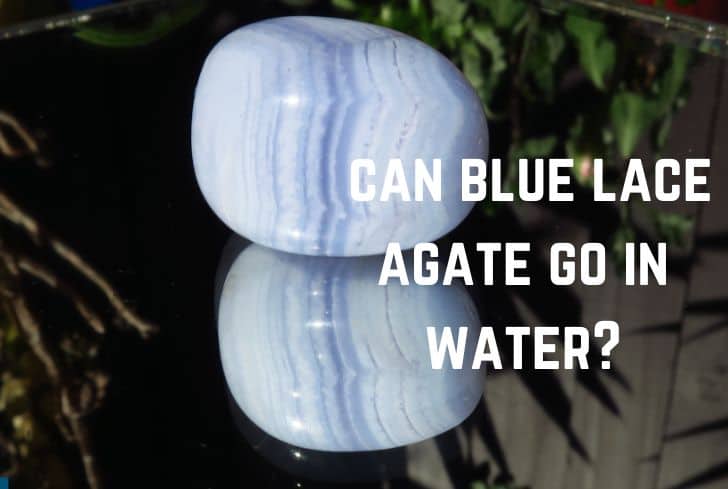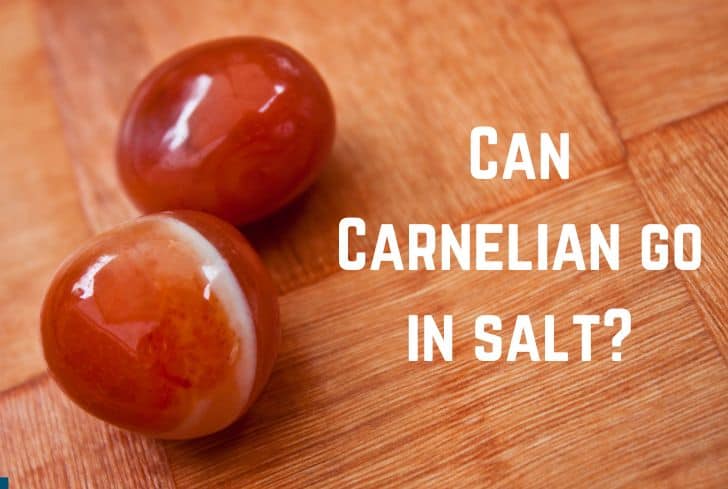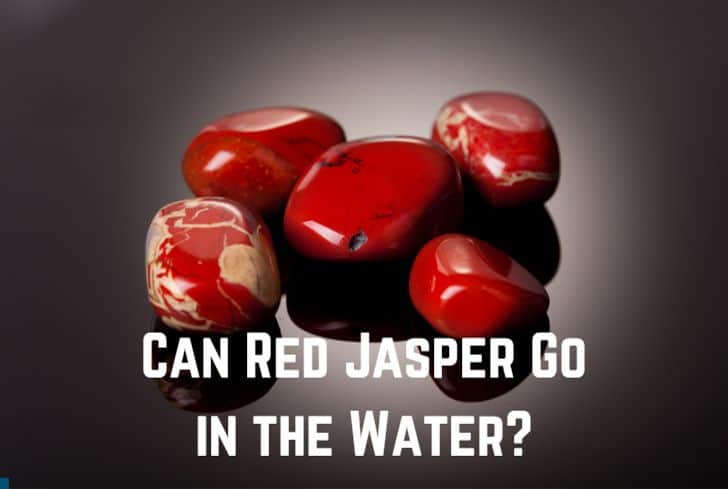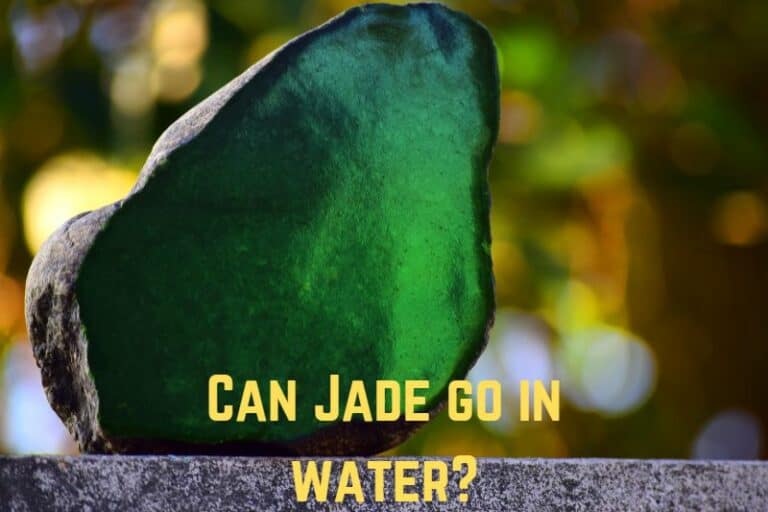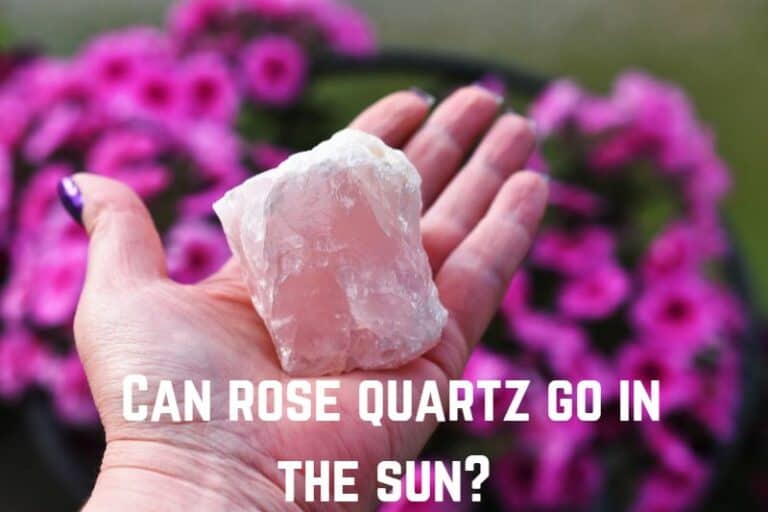Can Citrine go in the Water? (And Sun and Salt?)
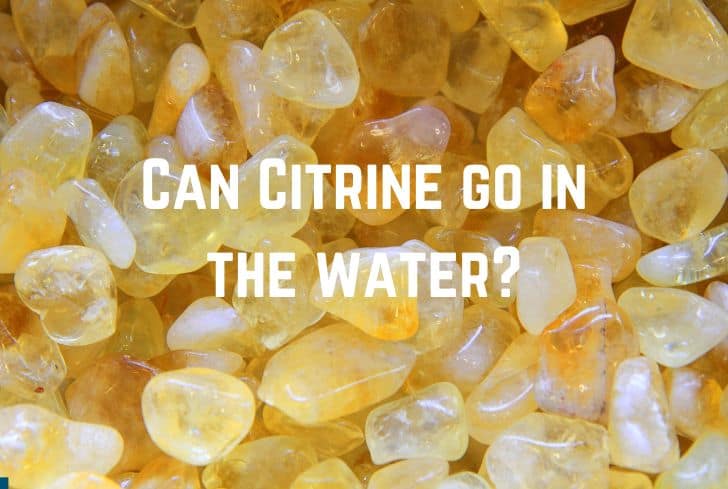
Citrine is a transparent variety of Quartz that is yellow to orangish-red in color. It is one of the most frequently purchased yellow gemstones, thanks to its attractive color, low price, high clarity, and durability. The name comes from the Latin term citrina meaning “yellow”, which is also the source of the fruit citron’s name.
Have you ever wondered if Citrine can go in the water? In this article, we are going to discuss just that. We will begin with the properties of citrine. Then we will discuss its interaction with various elements like water, the sun, and the moon. Finally, we will learn how to clean and charge citrine properly
Read: Can Aquamarine go in the Water
Is Citrine Water Safe?
Yes, Citrine can safely go in water. It has a value of 7 on the Mohs Hardness Scale, which is well above the minimum value required for minerals to go underwater. However, like all stones, citrine should not be immersed for too long. Over extended periods, water can dull the appearance or damage the structure of the stone.
Mohs Hardness Scale is a relative measure of a mineral’s resistance to scratching. Besides that, it also indicates a stone’s relationship to water. Usually, a value above 5.0 means that the stone is safe to go underwater.
Softer stones like selenite (value of 2.0 on the Mohs Scale) should never be immersed in water. But even harder minerals like citrine should not be immersed for long. Water enters the crevices of the stone and widens the cracks. These fissures may not be visible at first but can slowly damage the structure of the stone, making it prone to getting damaged upon impact.
Water also tends to tarnish the appearance of crystals. It strips off their polish (usually done with oil) and makes them look duller. Fissures, encouraged by water, can also impact the way light bounces inside the stone, and this can ruin the optical properties of the stone.
What are the Properties of Citrine?
These are the properties of Citrine
- Colour: Citrine ranges from yellow to orangish-red in color. This distinctive color in the stone is because of the presence of ferric iron. The yellow color is mostly associated with Topaz, which is why these two gems are often confused. The more saturated the stone, the higher the value; those with lighter tones and smoky appearances are cheaper. Reddish orange stones are rarest and called Madeira Citrine.
- Structure: Citrine has no cleavage and breaks with a conchoidal fracture. In terms of diaphaneity, it is transparent. Larger sizes of the stone are easily available, which is why there is no exponential increase in value per carat. Besides crystals, the stone is also found in the form of geodes (going up to several feet in height). These are mostly found in the Basalt fields of Brazil and used as crystal towers in the house.
- Hardness: Citrine has a value of 7.0 on the Mohs Hardness Scale, meaning that it is a reasonably hard stone and can go in the water. Topaz has a value of 8.0 on the Mohs Scale, which might lead some people to think that it is a better alternative than Citrine. However, Citrine has a much better tenacity, meaning that it doesn’t break easily upon impact. Moreover, it is cheaper than Topaz.
- Composition: Citrine is a variety of Quartz, which is made up of silica (silicon dioxide or SiO2). It has submicroscopic ferric hydroxide impurities and these give the stone its distinctive yellow color. Natural citrine has a smoky or cloudy appearance while heat-treated amethysts will have small lines in the crystal.
- Occurrence: Small quantities of citrine are found all over the world, but the most the pegmatite stones of Brazil are the most important source. A very small quantity of citrine is natural; most of the commercial citrine is amethyst or smoky quartz that has been heat-treated. Citrine can also be created synthetically; these man-made stones have higher clarity, are significantly cheaper, and can be created in abundant quantities.
Besides these physical properties, citrine also has various spiritual properties associated with it. It is often referred to as the “merchant’s stone” or “money stone” because it is believed to bring prosperity. It is associated with positivity and optimism, thanks to its cheerful color.
It is also said to activate the solar plexus chakra, helping people with confidence and personal power. Check out this video to learn more about the spiritual properties of citrine.
Can Citrine go in Salt Water?
No, citrine should not be put into salt water. Citrine has a value of 7.0 on the Mohs Hardness Scale, meaning that it is safe to go underwater. However, it should still not be immersed for too long as water can be damaging. When we bring salt into the mix, it aggravates the corrosive process.
When dissolved in water, salt can enter the crevices of the stone. Here, the particles stay even after the water evaporates, and they cause the cracks to widen. These fissures can slowly damage the structure of the stone.
Salt also makes the surface of the stones duller. Finally, salt can also combine with the elements of the mineral and react adversely. This is especially true for minerals like citrine which contain iron. Salt hastens the rusting process by making the metal lose its electrons more easily.
Read: Can Amethyst go in the Water?
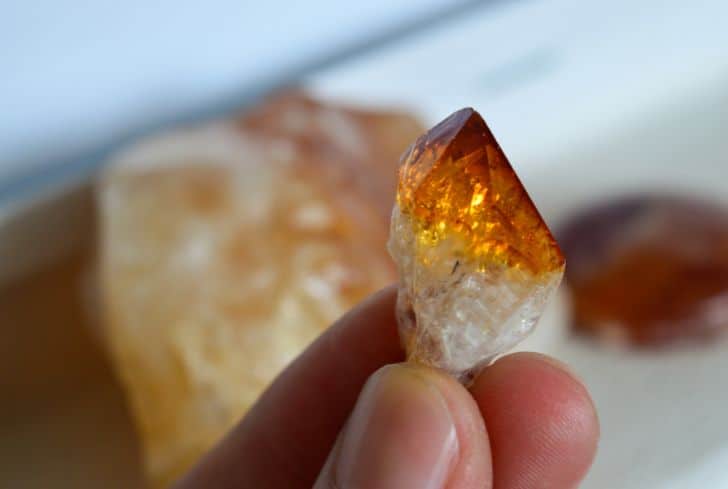
Can Citrine go in the Sun?
No, citrine should not go in the sun. While keeping stones in sunlight is a popular way of recharging them, it is not appropriate for all crystals. Prolonged exposure to sunlight will dull the color of citrine because it affects the ferric hydroxide present in the stone. Other cleaning and charging alternatives should be used for citrine.
The distinctive color of citrine comes from the presence of submicroscopic particles of ferric hydroxide. When the stone is exposed to sunlight for a long time, the trademark yellow color of the stone will fade, severely damaging its appearance and value.
For cleaning citrine, the best method is to use soap water. Keep reading below to find the detailed steps. Instead of sunlight, use moonlight or smudging to recharge your stone.
Can Citrine go in Salt or Himalayan Salt?
Yes, citrine can go in the salt. Although salt water is quite harmful to citrine, dry salt is safe. Putting stones in a bed of salt is a popular way of recharging them, and it is perfectly safe for citrine.
Without the help of water, salt is not able to enter into the crevices of the stone, and therefore cannot cause fissures. Surface contact between citrine and salt doesn’t hurt the former because its hardness is significantly higher than that of salt.
Citrine can also be safely put in Himalayan salt. Himalayan salt is rock salt with a pinkish tint and it is mined from the Punjab region of Pakistan. It is usually used as an alternative to refined salt or as a decorative food item.
Putting citrine in Himalayan salt is also safe. As long as the salt is dry (not dissolved in water), it will not harm the stone.
Can citrine go in the Moonlight?
Yes, citrine can go in the moonlight. Keeping crystals out in moonlight is a common method of recharging them, and it is safe for citrine. Unlike the harsh rays of the sun (which are damaging to citrine), moonlight is gentle and will fill your stone with its energies.
To charge your stone with moonlight, simply take a bowl and fill it with water. Immerse the stone in the bowl and place it where it gets sufficient moonlight. Leave the stone overnight and it will be recharged with the energies of the moon.
Most people prefer a full moon night when recharging a crystal; times of eclipses are usually avoided, as they are believed to be associated with negative energies.
How do You Cleanse and Charge Citrine?
Follow these steps to clean citrine:
- Mix a soft detergent/soap with lukewarm water.
- Immerse the stone in the water for a few minutes and clean it with a soft brush.
- Rinse the stone under running water to get rid of excess soap.
- Let the stone air dry. Make sure you twist the stone around a few times to get rid of water from the crevices.
Heat-treated stones can fade when exposed to heat. This is why steam cleaning or boiling methods are not recommended for citrine. Ultrasonic cleaners are safe for the stone, although cleaning the stone with soap water as discussed above is much easier.
Citrine is usually free of inclusions, but stones having low clarity (having liquids, gases, or crystals trapped within them) should be cleaned by hand only.
Citrine has a value of 7.0 on the Mohs Hardness Scale, meaning that it can safely go underwater. However, it should still be treated with care in everyday use. Make sure that you remove the stone when engaged in physical activities like exercising or swimming.
Conclusion
In this article, we have discussed whether citrine can go in the water or not. With a value of 7.0 on the Mohs Hardness Scale, citrine is a relatively hard mineral and is safe to go underwater. However, like all stones, citrine should not be immersed for long. We looked at the stone’s interaction with different elements and finally talked about taking care of it.

